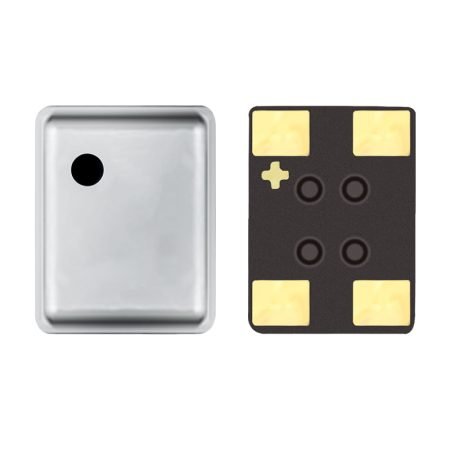목록
압력 센서가 냉간 시동에서 작동 온도로 전환될 때 예열 드리프트가 발생하여 출력이 불안정해집니다. 의료용 인공호흡기 및 신생아 모니터링 장비와 같은 중요한 응용 분야에서는 사소한 드리프트도 환자 안전에 영향을 미칩니다. 기존의 압저항 센서는 실리콘 다이어프램과 휘트스톤 브리지에 구성된 4개의 압저항 요소로 구성됩니다. 전원이 공급되면 저항 가열로 인해 온도 변화가 발생하여 열 평형이 이루어질 때까지 신호 드리프트가 발생합니다.
1. 센서소자 열효과 제어
여기 전압 영향 감소
압저항 소자 온도 상승은 여기 전압(ΔT∝V²)과 2차 관계를 따릅니다. 전압을 50% 줄이면 온도 상승이 75% 감소하여 예열 드리프트가 크게 낮아집니다. 신호 강도는 비례적으로 감소하지만 순 효과는 여전히 드리프트를 절반으로 줄입니다. 그러나 전압이 낮아지면 시스템 잡음이 증가하므로 신호 대 잡음비와 드리프트 성능 간의 균형이 필요합니다.
펄스 전원 공급 장치 기술
시스템 대역폭 요구 사항에 따라 간헐적인 전원 공급 장치를 구현하여 측정 중에만 센서에 전원을 공급합니다. 예를 들어, 정착 시간 4ms, 획득 시간 1ms로 500ms마다 샘플링하는 장치는 연속 작동에 비해 평균 전력을 1%만 사용합니다. 이 방법은 열 축적을 획기적으로 줄이고 예열 드리프트를 효과적으로 억제합니다.

2. 온도 보상 전략 최적화
온도 구배 문제 제거
기존의 이중 센서 시스템은 외부 온도 센서와 압력 센서 다이어프램 사이에 온도 구배를 생성합니다. 경사도 안정화 프로세스는 워밍업 드리프트로 나타납니다. 보다 효과적인 접근 방식은 압력 센서의 자체 저항 온도 계수를 사용하고 브리지 저항을 온도 감지 요소로 직접 사용하여 공간적 온도 차이를 제거하는 것입니다.
셀프 보상 회로 설계
센서 브리지의 양의 온도 계수를 활용하여 모니터링 전압은 온도 증가에 따른 음의 변화를 보여줍니다. 이 변화를 기준 전압과 비교하면 센서 온도 정보가 정확하게 제공됩니다. 시스템 전자 장치는 이 데이터를 기반으로 실시간 보정을 수행하고 빠른 응답 자체 보상 메커니즘을 통해 외부 센서 지연 효과를 제거합니다.
3. 구조 설계 개선
열 분리 기술
센서 패키징에 열 절연 구조를 도입하여 민감한 요소에 대한 환경 온도 영향을 줄입니다. 최적화된 열 경로 설계를 통해 열전도율이 낮은 재료를 절연층으로 사용합니다. 적절한 PCB 레이아웃은 가열 구성 요소를 센서 영역에서 멀리 유지하여 열 안정성을 크게 향상시키고 예열 시간을 줄입니다.
재료 속성 최적화
온도로 인한 응력 변화를 줄이려면 열팽창 계수가 일치하는 재료 조합을 선택하십시오. 실리콘 다이어프램과 포장재 사이의 열 매칭은 센서 온도 안정성에 직접적인 영향을 미칩니다. 응력 완화 설계 및 저응력 패키징 프로세스는 온도 변화 중에 출력 안정성을 더욱 향상시킵니다.
4. 시스템 수준의 제어 기술
예열 및 사전 조건
중요한 응용 분야에서 예열 전략을 구현하고 공식 측정 전에 센서를 잠시 가열하여 작동 온도에 빠르게 도달합니다. 이 방법은 간헐적인 작동 장비에 적합합니다. 예열 전력 및 지속 시간은 민감한 요소의 과열 손상을 방지하기 위해 센서 열 시상수를 기반으로 정확한 계산이 필요합니다.
동적 교정 알고리즘
실시간으로 센서 출력 추세를 모니터링하고 워밍업 드리프트 패턴을 식별하는 지능형 교정 알고리즘을 개발합니다. 드리프트 보상 모델을 설정하면 소프트웨어 수준의 신호 수정이 가능해집니다. 이 접근 방식은 하드웨어 최적화와 소프트웨어 처리 이점을 결합하여 고정밀 애플리케이션에 대한 추가 보증을 제공합니다.
5. 실용화 검증
의료 기기 응용 프로그램
인공호흡기 및 모니터링 장비에서 펄스 전원 공급 장치와 자체 온도 보상을 결합하면 예열 드리프트가 ±0.1%FS 이내로 줄어듭니다. 테스트에서는 최적화된 센서가 30초 이내에 장기적인 안정성 정확도를 달성하여 엄격한 의료 기기 요구 사항을 충족하는 것으로 나타났습니다. 이러한 성능 개선은 환자 모니터링의 정확성과 안전성에 큰 영향을 미칩니다.
산업 공정 제어
산업 자동화에서 포괄적으로 최적화된 압력 센서는 열악한 조건에서도 안정적인 성능을 유지합니다. 온도 충격 테스트 결과 드리프트 복구 시간이 60% 이상 단축되어 생산 라인 가동 효율성과 제품 품질 안정성이 크게 향상되었습니다.
결론
압력 센서 예열 드리프트를 최소화하려면 여러 차원에 걸쳐 조정된 개선이 필요합니다. 전력 관리는 낮은 여기 전압과 펄스 공급을 통해 열 발생을 줄입니다. 온도 보상은 기울기를 제거하는 자체 보상 기술을 사용합니다. 구조 설계는 단열 및 재료 매칭을 강조합니다. 시스템 제어는 예열과 동적 교정 알고리즘을 결합합니다. 이러한 기술을 포괄적으로 적용하면 허용 가능한 범위 내에서 예열 드리프트를 제어하여 다양한 응용 분야에서 안정적인 센서 성능을 보장합니다. 고정밀 애플리케이션의 경우 조합 접근 방식은 최적의 드리프트 제어 효과를 제공합니다.
위의 소개는 압력 센서 기술 적용의 표면적인 부분에 불과합니다. 우리는 다양한 제품에 사용되는 다양한 유형의 센서 요소, 작동 방식, 장점과 단점을 계속해서 탐구할 것입니다. 여기에서 논의된 내용에 대해 더 자세히 알아보려면 이 가이드 뒷부분의 관련 콘텐츠를 확인하세요. 시간이 촉박한 경우 여기를 클릭하여 이 가이드의 세부정보를 다운로드할 수도 있습니다. 공기 압력 센서 제품 PDF 데이터.
다른 센서 기술에 대한 자세한 내용은 다음을 참조하십시오. 센서 페이지를 방문하십시오.
